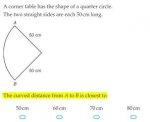Calculate Distance of Curved Side
- Thread starter devitius
- Start date
BigGlenntheHeavy
Senior Member
- Joined
- Mar 8, 2009
- Messages
- 1,577
Sector of a Circle:
AB = rθ, r = 50cm., what does θ equal?
AB = rθ, r = 50cm., what does θ equal?
Ok, the angle must be 90 degrees because it is a quarter circle. So, from my calculations, the answer would be:
AB = r? = (50cm) x (?/2) = 50cm x 1.57 = 78.54
So the answer would be D - closest to 80cm.
I should have figured by simply dividing the equation of the circumference of a circle by 4. So:
Circumference of a circle = 2?r / 4 = ?r / 2
This particular question was actually directed towards year 9 students in a generic test on numeracy. This makes me wonder if such students would be expected to derive this equation, or whether or not there is some other "rough" way of going about this to find an estimation (esp. considering the answers themselves are estimates).
AB = r? = (50cm) x (?/2) = 50cm x 1.57 = 78.54
So the answer would be D - closest to 80cm.
I should have figured by simply dividing the equation of the circumference of a circle by 4. So:
Circumference of a circle = 2?r / 4 = ?r / 2
This particular question was actually directed towards year 9 students in a generic test on numeracy. This makes me wonder if such students would be expected to derive this equation, or whether or not there is some other "rough" way of going about this to find an estimation (esp. considering the answers themselves are estimates).
I doubt if the students at this level are expected to derive s=rθ.
Just know how to use it correctly.
It can be derived through calculus.
Or use proportions;
2πrs circle circumferencelength of arc=2πθ central angle of circlecentral angle of sector
Now, solving for s gives the formula.
Just know how to use it correctly.
It can be derived through calculus.
Or use proportions;
2πrs circle circumferencelength of arc=2πθ central angle of circlecentral angle of sector
Now, solving for s gives the formula.
Just as they wouldn't be expected to derive the circumference of a quarter circle from the equation of a full circumference, they certainly wouldn't be expected to derive it though calculus 
Any ideas for a "rough" method for estimating this answer?
Any ideas for a "rough" method for estimating this answer?
Sorry, I didn't mean "derive" is in have the yr9 students come up with the equation from basic principles, rather to recognize that they require the need of that specific equation.
Basically what I'm saying is that this test, including this question, was likely to have been designed so that the students could problem-solve the questions rather than requiring the need to recall specific equations.
So I'm wondering if there is another "rough" method of estimating the answer which doesn't require knowing this equation?
Or would you expect that every junior high school student should know the equation for the cirumference of a circle from heart and realize they could modify it to apply it to a quarter circle. Otherwise, the question would discrimate on some part (and be poorly designed).
Basically what I'm saying is that this test, including this question, was likely to have been designed so that the students could problem-solve the questions rather than requiring the need to recall specific equations.
So I'm wondering if there is another "rough" method of estimating the answer which doesn't require knowing this equation?
Or would you expect that every junior high school student should know the equation for the cirumference of a circle from heart and realize they could modify it to apply it to a quarter circle. Otherwise, the question would discrimate on some part (and be poorly designed).
Learn the formula would be my advice. It is not a very large and complicated one.
Just make sure to tell the students that theta is in radians.
Or, use degrees and then convert.
For instance, with this problem, using degrees:
50(90)=4500
4500(180π)=25π as before.
Just make sure to tell the students that theta is in radians.
Or, use degrees and then convert.
For instance, with this problem, using degrees:
50(90)=4500
4500(180π)=25π as before.
BigGlenntheHeavy
Senior Member
- Joined
- Mar 8, 2009
- Messages
- 1,577
If the student knows that C = 2πr (which he/she should), then it is a short hop
to: AB = 4C = 42πr = 2πr = 250π = 25π.
to: AB = 4C = 42πr = 2πr = 250π = 25π.

